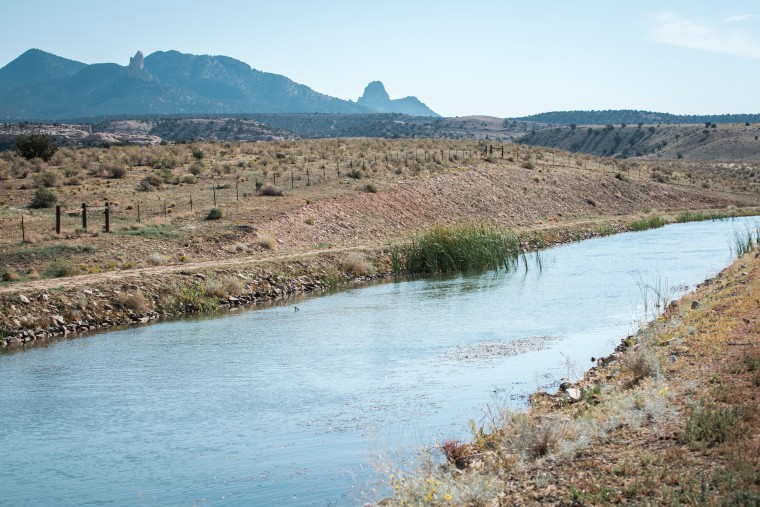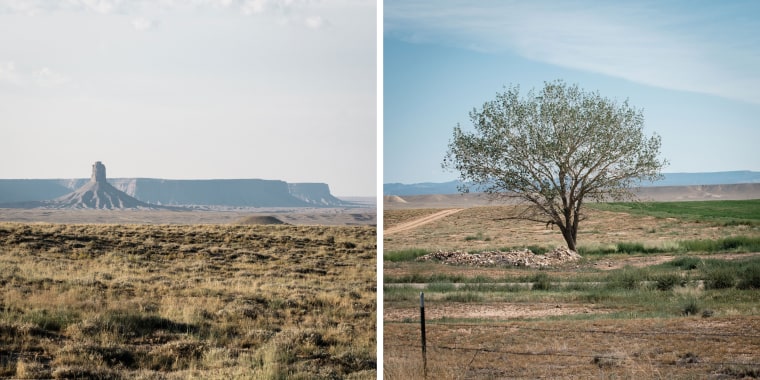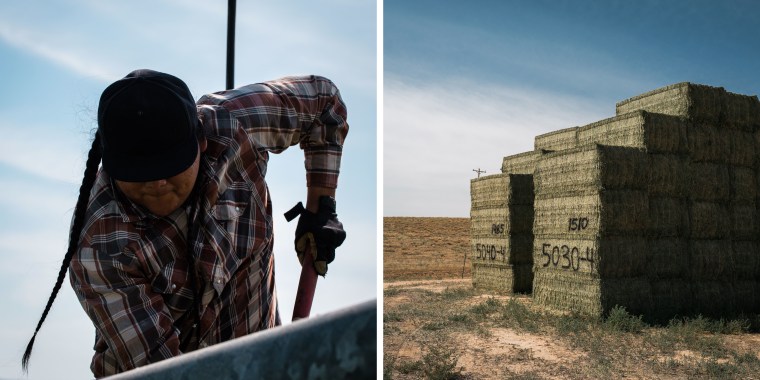The Ute Mountain Ute Tribe, which has operated the farm and ranching enterprise for four decades, received only 10% of its water allocation last year.
Sept. 11, 2022, 6:00 AM EDT
Create your free profile or log in to save this article
TOWAOC, Colo. — A way of life and sustenance for a small tribe in the high desert of southern Colorado is under threat by the Western drought, which has left a reservoir used to irrigate farmland perilously low.
The 7,700-acre Ute Mountain Ute Tribe Farm & Ranch Enterprise has produced alfalfa and corn for four decades, irrigated by snow melt flowing from the surrounding San Juan Mountains.
But higher temperatures and less runoff feeding into the nearby McPhee Reservoir have led to a slowdown in production over the past two years, costing the farm from $4 million to $6 million last year. The losses combined with the pandemic forced the company to lay off more than half its workforce of 50.
The remaining 20 or so employees, who earn $15 to $25 an hour, are members of the Ute Mountain Ute Tribe, part of the Weeminuche band of the Ute Nation. Many view their work as a contribution to their Indigenous society and are proud that the fruits of their labor make their way into items sold in grocery stores.
Because the tribe derives most of its revenue from the Ute Mountain Casino Hotel, members said the farm’s significance goes beyond dollars and cents.
“It means we have something of our own,” said Kolton Begay, 22, who has worked at the farm for six years. “It provides jobs for some of the people around here. It does mean a lot to a lot of people.”
The Ute Mountain Ute Tribe is among dozens of tribes across the Southwest contending with the region’s two driest decades in at least 1,200 years.
The Navajo Nation, which has the largest reservation in the U.S. at more than 25,000 square miles in parts of Arizona, New Mexico and Utah, uses about 2 million gallons of water every day to feed livestock, but more is needed, the Navajo Nation Department of Water Resources said in a 2021 report.
The department’s director, Jason John, said it would take $10 million to address drought and mitigation.
“Throughout the arid Southwest, and especially on the Navajo Nation, reliable water supplies are essential for starting and sustaining economic development,” officials said on the department’s website.
The 2,100-member Ute Mountain Ute Tribe has inhabited the land in the present-day Four Corners region, where Colorado, New Mexico, Arizona and Utah meet, for 10,000 years, leaders said.

The once nomadic tribe hunted big game and gathered grasses and fruits for nourishment. The people moved with the seasons, following wild animal herds to feed their families, said tribal chairman Manuel Heart.
“We roamed these mountains as the stewards,” he said. “We are the mountain people. We take care of these mountains based on the seasons and the game.”
Federal laws that set boundaries for reservations ultimately pushed the Utes to the southwestern edge of Colorado.
Today, its 60,000-acre reservation at the base of Sleeping Ute Mountain overlooks desolate terrain that stretches into Utah and New Mexico
With sales falling, Ute farmers have turned to milling corn for whiskey distilleries. The tribe also packages cornmeal to use as an ingredient in pancake mix, cornbread and tortillas sold in stores throughout the Southwest, farm officials said.
Tribal leaders could not provide an exact figure for how much the milling and cornmeal operations generate but said it was not enough to offset projected losses caused by drought.


The farm remains viable with the help of state and federal grants that cover labor costs and other bills, said general manager Simon Martinez. He estimated the farm would receive more than $2 million in grants this year.
“If we weren’t getting grants, it would be catastrophic,” Martinez said.
As the drought grinds on, some leaders said they could be forced to sell their livestock, including 600 black angus cross cows, kept in pastures away from the farm and sold to slaughterhouses for beef.
But Heart said he does not think the farm will have to close or sell off assets. He said the tribe has senior water rights from a lake near Durango, Colorado, and from the San Juan River in New Mexico stemming from a 1968 treaty with the U.S. Department of the Interior.
But pumping the water or creating a pipeline from those locations to the farm could cost hundreds of millions of dollars, which may not be feasible, farm officials said.
Last year, the Ute farm received 2,622 acre-feet of water, a little more than 10% of the 24,517 of acre-feet it usually receives, said Ken Curtis, general manager of the Dolores Water Conservancy District, which distributes water from the McPhee Reservoir. An acre-foot can supply two families of four with water for a year.

“It’s awfully hard to yo-yo like that, and so they’re struggling,” Curtis said of the Ute tribe.
Martinez said he remains optimistic about the farm’s long-term prospects and before taking any drastic steps, he would likely change the structure of the business to focus on growing and selling hay and sunflowers to make oil.
“We have to try to stay afloat until Mother Nature decides to go back to the weather patterns that we’re used to in years past,” Martinez said. “Will it? I don’t know.”
Deon J. Hampton is a national reporter for NBC News.




